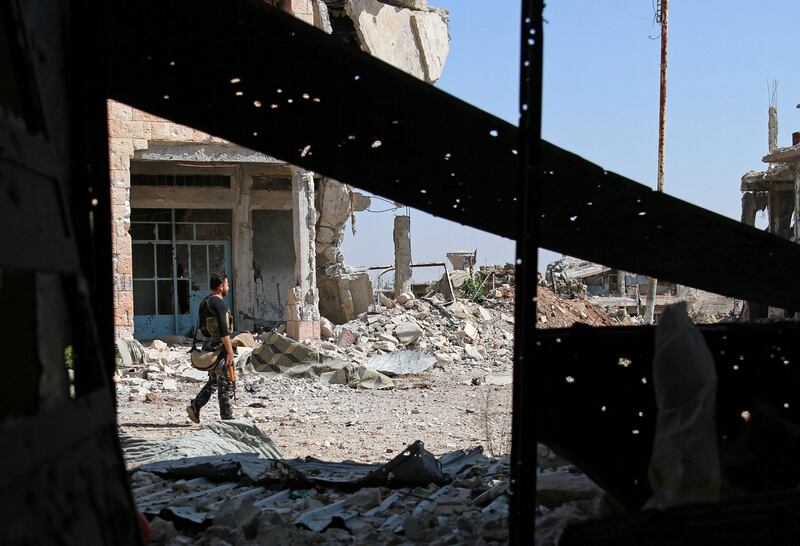BEIRUT// A ceasefire brokered by the United States, Russia and Jordan in southwestern Syria appeared to be largely holding after going into effect at 12pm (1pm UAE) on Sunday.
No air strikes or clashes were reported across the country’s three southern provinces in the first hours of the truce, said the Syrian Observatory for Human Rights, a Britain-based group monitoring the war in Syria.
The ceasefire deal is believed to include a “de-escalation zone” covering the provinces of Deraa and Sweida, on the border with Jordan, and Quneitra province, which borders the Israeli-occupied Golan Heights.
The Syrian government announced a unilateral ceasefire in the area last week to bolster peace talks in the Kazakh capital, Astana, and extended it until Saturday. But rebel fighters accused the government of violating that ceasefire with air strikes and artillery attacks.
Damascus has yet to comment on the new US-Russian-Jordanian agreement that went into effect on Sunday.
The open-ended ceasefire between the Syrian government and its allies and rebel forces is potentially the first move towards broader co-operation between Washington and Moscow in Syria and marks the Trump administration’s most serious foray yet into peacemaking in the country.
“I think this is our first indication of the US and Russia being able to work together in Syria,” US secretary of state Rex Tillerson said in Hamburg on Friday, the same day president Donald Trump and his Russian counterpart, Vladimir Putin, held their first direct talks on the sidelines of the G20 summit.
Mr Tillerson had said earlier last week that the US was open to co-operating with Moscow on no-fly zones, ceasefire observers and the delivery of humanitarian aid in Syria. Co-operating with Moscow, Mr Tillerson said, would “lay a foundation for progress on the settlement of Syria's political future”.
US president Donald Trump tweeted on Sunday that the ceasefire “will save lives”.
Washington’s sudden interest in peacemaking is an about turn for an administration that had seemed uninterested in getting involved in resolving Syria’s six-year civil war.
The US says its motives for co-operating with Russia lie in ending the conflict and alleviating the suffering of civilians, but observers are sceptical. They say Washington is trying to cement co-operation with Russia against ISIL as both countries seek to exit — or at least simplify — the complicated war that their forces have become ensnared in.
While Washington and Moscow have backed opposing sides in the civil war, with Russia fighting on the side of Syrian president Bashar Al Assad and the US calling for his departure from power, the two countries have found common ground on fighting ISIL and wanting to end the conflict.
There is hope that the newfound co-operation between the US and Russia — as well as the new ceasefire — will nudge along peace talks that have so far failed to find a settlement to the conflict. The seventh round of UN-sponsored talks in Geneva is set to begin on Monday.
Ramzi Ezzedine Ramzi, deputy to the UN’s Syria envoy Staffan de Mistura, said on Saturday the ceasefire “helps create a suitable atmosphere for the talks, and we will see that on Monday”.
Frustrated with the chronic lack of progress since the UN-backed peace process began in 2012, a parallel set of negotiations sponsored by Russia, Iran and Turkey — all countries active militarily in the conflict — was established in the Kazakh capital of Astana last year.
The new ceasefire will immediately face major challenges.
Analysts see Russia as unable to control its ally Damascus and keep Mr Al Assad’s forces from escalating the conflict. And Moscow has even less of a hold on Iran-backed pro-government forces such as Hizbollah that are active across the country.
There are also questions over the capacity of the US to guarantee a ceasefire. Although rebel forces have called for American intervention since the early days of the conflict, many became distrustful of Washington over the years as the US grew increasingly distant and wary of them. Eventually, when president Mr Trump took office in January, the US withdrew from peacemaking efforts altogether.
It is not clear which rebel groups have signed on to the southern ceasefire and what guarantees they may have received from Washington and Amman.
Rebels have viewed past major ceasefires as regime ploys to prepare for assaults. With the rebels still outmatched by government forces, there appears to be little reason for the Syrian government and its allies to agree to the latest ceasefire save to take a break and bow to Russian pressure.
At the peace talks in Astana last week, a Syrian opposition delegation condemned ceasefires that cover only parts of the country, warning that such agreements risked dividing the country and causing splits in the ranks of the opposition.
The continuation of fighting between rebels and government forces in other areas of the country will likely strain the ceasefire in the south-west, with opposition fighters elsewhere likely to call on their comrades to continue fighting if they are under attack.
As past attempts at ceasefires have shown, any flare-ups in fighting could quickly derail the entire process.
* Additional reporting by Reuters and Agence France-Presse





